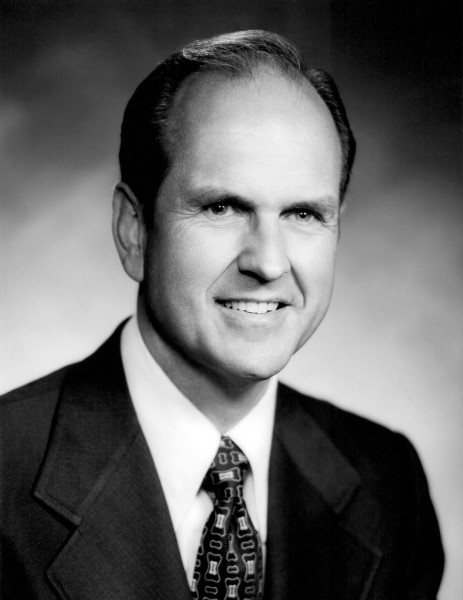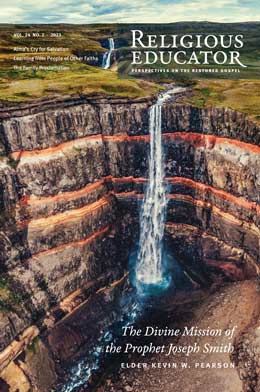Stanley A. Johnson, "A Prophetic Pioneer: Reflections on Footnotes and President Russell M. Nelson," Religious Educator 24, no. 2 (2023): 34–39.
Stanley A. Johnson (stanalanjohnson@gmail.com) is a professor emeritus of ancient scripture at BYU.
 President Nelson was the first General Authority or General Officer of the Church to include endnotes in a printed conference edition of the Ensign. Courtesy of Intellectual Reserve, Inc.
President Nelson was the first General Authority or General Officer of the Church to include endnotes in a printed conference edition of the Ensign. Courtesy of Intellectual Reserve, Inc.
Keywords: Apostles, doctrine, First Presidency, General Authorities, prophets
For over forty years, I have diligently studied the general conference editions of the Ensign to help me as a teacher, leader, and professor in Religious Education at BYU. On one of these occasions, I was studying an address given by President Russell M. Nelson titled “Self-Mastery.”[1] This address was given in the October 1985 general conference and printed in the November Ensign of the same year. As I came to the end of the address, I noticed that President Nelson had listed twenty-six endnotes related to the subject of self-mastery and enduring to the end. Although I had studied this talk many times before, this time the endnotes caught my attention. In most of the talks from this era, including endnotes was not commonplace, and I wondered if it had ever been done before this talk by President Nelson. This prompted me to further investigate all my copies of general conference from 1975 to the present day. I discovered that President Nelson was the first General Authority or General Officer of the Church to include endnotes in a printed conference edition of the Ensign. President Nelson, at the time a new member of the Quorum of the Twelve Apostles, was doing something unprecedented for any of the General Authorities. He showed he would be a prophetic pioneer by including endnotes to help us deepen our ability to understand and nurture our personal study and inspiration. This small and simple act has become the standard for almost all the General Authorities.
For seven years, President Nelson was the only General Authority who included references at the end of his printed addresses. However, in the May 1992 Ensign, President Thomas S. Monson of the First Presidency also included endnotes after not one but four of his general conference addresses.[2] In the May 1993 Ensign, along with President Monson and then-Elder Nelson, President Boyd K. Packer also included references at the end of his talk.[3] From that point forward, including endnotes or footnotes became far more common. President Nelson, our prophet today, was a pioneer in providing reference help for members to better understand his messages. He began including references far ahead of the current information age, in which including endnotes and footnotes has become the norm. For many years our current prophet has been emphasizing a more personal effort to immerse ourselves in the word of God.
I have always been deeply impressed by the amount of study and in-depth research behind each address given by President Nelson. If the leaders of the Church spend the time and effort to include references when their time is limited and their schedules full, should we not pay attention? Often the General Authorities have much more to say than what they can present at the pulpit or even in a printed address. Adding references is one way they can share that additional knowledge. We are missing out if we simply pass over these treasures of knowledge from the leaders of the Church. For example, in his 1995 general conference address entitled “Perfection Pending,” President Nelson went to great lengths to explain the word perfection as found in Matthew 5:48 in the King James Bible. He explained that the word perfection comes from the Greek word teleios, which means “complete.” He went on to explain more about the various forms of this word: “Teleios is an adjective derived from the noun telos, which means ‘end.’ The infinitive from of the verb is teleiono, which means ‘to reach a distant end, to be fully developed, to consummate, or to finish, . . . Please note,” he said, “that the word [perfect] does not imply ‘freedom from error’; it implies ‘achieving a distant objective.’” He further explained that “teleios is not a total stranger to us. From it comes the prefix tele- that we use every day. Telephone literally means ‘distant talk.’ Television means ‘to see distantly.’ Telephoto means ‘distant light,’ and so on.”[4] After carefully explaining these details in his address over the pulpit, he also included forty-two additional references in the November 1995 Ensign.[5]
As leaders and teachers in the Church, we can learn from President Nelson’s example of including references. I believe President Nelson is trying to encourage deeper immersion into the doctrines of the gospel. President Ezra Taft Benson once said, “When individual members and families immerse themselves in the scriptures regularly and consistently, these other areas of activity will automatically come. Testimonies will increase. Commitment will be strengthened. Families will be fortified. Personal revelation will flow.”[6] Although references do not establish doctrine, they are an invitation to immerse ourselves in gospel topics deemed important by the prophets, apostles, and leaders of the Church. The references give us a unique insight into what these leaders have learned in their studies, and they can guide us in our own personal study.
 To go beneath the surface of water, one must add a face mask, snorkel, and fins—analogous to preparing ourselves with the proper tools of study. Photo by NEOM, Unsplash.com.
To go beneath the surface of water, one must add a face mask, snorkel, and fins—analogous to preparing ourselves with the proper tools of study. Photo by NEOM, Unsplash.com.
With regards to this sort of study, I enjoy the analogy of someone trying to see clearly what is under water. This analogy illustrates the benefits of deeper immersion into the words of both ancient and living prophets. Many of us like to “stay in the boat” and not get wet—that is, not study the scriptures too deeply, remaining at the surface level. However, there are those that do like to get wet by jumping in and treading water. This is analogous to us slowing down and making time to enjoy the experience of personal study. To go beneath the surface of the water, one must add a face mask, snorkel, and fins—analogous to us preparing ourselves with the proper tools of study. Even by going just beneath the surface, one can begin to see a whole underwater world of fish and sea life that is new and thrilling. This is what happens when we take the time to study conference addresses more thoroughly—including by taking advantage of the additional references often provided. (An aside: as a benefit of modern technology, we can access these references in our electronic devices by simply tapping the source number provided in the text of the article, which then brings up the reference.) As we dive more deeply into these spiritual waters, new ideas and a deeper understanding of the doctrine will become thrilling to us. President Packer once said, “For His own reasons, the Lord provides answers to some questions, with pieces placed here and there throughout the scriptures. We are to find them; we are to earn them.”[7] The phrase that really caught my attention is “we are to earn them.” The references provide an opportunity for us to immerse ourselves in the doctrine, to go beneath the surface, to find and “earn” answers we did not even know were waiting for us.
President Nelson has proven to be a prophetic pioneer in many facets of the gospel, from new ministering and youth programs to his encouragement of home-centered, Church-supported learning. In comparison to these larger endeavors, including additional references with his addresses might seem insignificant, but these references are truly a great supplement for our personal study. As I have taken the time to study them, I have found amazing insights and doctrine that have had great influence upon me. I believe that President Nelson’s background as a medical researcher and heart surgeon taught him the importance of recording references to verify his findings, clarify the information given, and help encourage all those who would like to further study the subject on their own. He helped his fellow physicians and researchers in their development and progression in the medical field. Now, as a prophet, seer, and revelator, he helps all of us in our development and progression along the covenant path.
Notes
[1] Russell M. Nelson, “Self-Mastery,” Ensign, November 1985, 30–32.
[2] See Thomas S. Monson, “Memories of Yesterday, Counsel for Today,” 4–5; “To Learn, To Do, To Be,” 47–49; “An Attitude of Gratitude,” 54–60; and “The Spirit of Relief Society,” 100–102, all in the May 1992 Ensign.
[3] See Boyd K. Packer, “The Temple, the Priesthood,” Ensign, May 1993, 18–21.
[4] Nelson, “Perfection Pending,” Ensign, November 1995, 86–87.
[5] See Nelson, “Perfection Pending,” 86–88.
[6] Ezra Taft Benson, “The Power of the Word,” Ensign, May 1986, 81.
[7] Packer, “The Mystery of Life,” Ensign, November 1983, 17.
